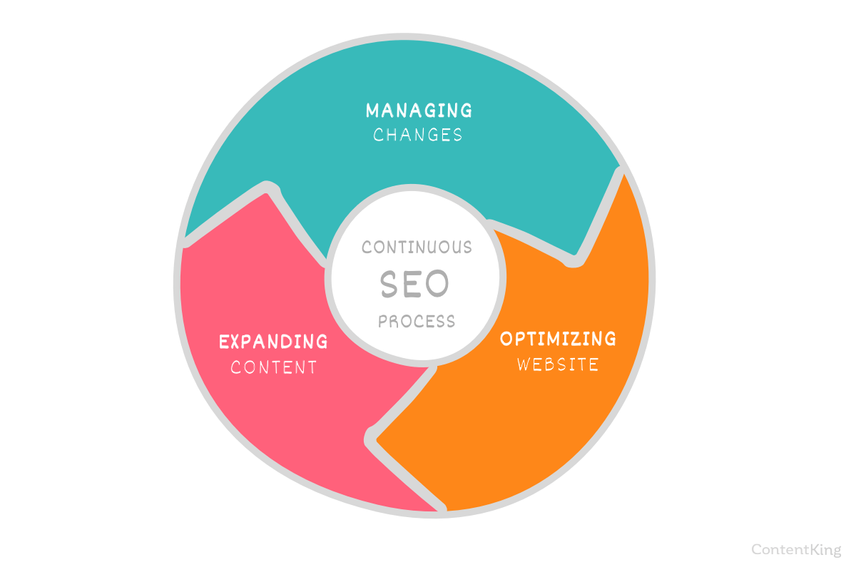The Continuous SEO Framework
The Continuous SEO Framework reflects the fact that SEO is an ever-changing field by nature and that no one should stick with the same processes and tooling forever.
It consists of three main pillars:
- Managing change: following the flow.
- Optimizing: realizing that content is never final.
- Expanding: exploring new possibilities.
Besides, it’s always necessary to take into account the current technology, the relevance of the content, and the authority the website has gained through links.
Why SEOs are consistently underperforming
SEO is continuous by nature, but the majority of SEOs stick to processes and tooling that aren't continuous. Often that's because they've created their SEO processes around the three pillars of SEO: Technology, Relevancy and Authority, or they may not have a process at all.
As a result they make mistakes, focus on the wrong things and important aspects of SEO fall between the cracks. And what does this lead too? You guessed it right: their SEO effort doesn't reach its full potential.
Ever wondered why some SEOs achieve far better results than others, while they have the same in-depth knowledge of SEO? They live by a framework that helps them to work on the right tasks, every step of the way.

If you want that too, you need to start with embracing the continuous nature of SEO and start thinking in terms of these three dimensions:
- managing change
- optimizing what you already have
- expanding
Each dimension breaks down into a set of tasks. The starting points of these tasks: spend your time on the right things, automate as much as you can, don't forget anything and be thorough.
We captured all of this in what we call The Continuous SEO Framework. The Continuous SEO Framework is the result of hundreds of discussions we've had with SEOs around the world. It's proved to be extremely useful to anyone that needs to deliver high SEO performance, despite their full ToDo list.
Starting points of The Continuous SEO Framework
It's important to explain the starting points of The Continuous SEO Framework.
Spend your time on the right things
You need to spend your time on the right things, at the right moment. When there are serious canonicalization issues in your websiteWebsite
A website is a collection of HTML documents that can be called up as individual webpages via one URL on the web with a client such as a browser.
Learn more, you shouldn't be doing outreach but instead focus on fixing those issues. When your content sucks, you first need to fix that before doing outreach.
Automate as much as you can
Let machines do what they do best, so you can do what you're best at. It's obvious, but too often we're seeing people performing repetitive tasks which could easily be automated.
Tasks such as checking whether pagePage
See Websites
Learn more titles and meta descriptions changed or whether links to a website were lost should be automated. The result of the tasks should only be interpreted by a person.
Don't forget anything
People forget things for many reason. Having a solid framework to fall back on prevents you from forgetting anything. Should you be unable to do everything, at least you can make a conscious decision to skip a certain task that's not going to bite you.
The Continuous SEO Framework
The Continuous SEO Framework is centered around the three dimensions of SEO:
- Managing change: keeping tabs on what's happening.
- Optimizing: constantly optimize what you already have.
- Expanding: expand on what you have.
Within each dimension we use the pillars of SEO to group the tasks. While the pillars of SEO shouldn't be leading in defining the framework, they come in handy in grouping tasks within each dimension:
- Technology: the technical foundation of the website that influences crawling and indexing.
- Relevance: meta information and content explaining to search engines what your website is about.
- Authority: links to your website, which determine your authority and trustworthiness.
The outline of the framework is starting to show:
Managing change
- Technology: were there any technical changes, and are they good or bad?
- Relevance: did any of the content change, and is this good or bad?
- Authority: did you gain or lose links, and is this good or bad?
Optimizing
- Technology: how to optimize crawling and indexing?
- Relevance: how to optimize existing content?
- Authority: how to optimize existing links?
Expanding
- Technology: what new developments can you benefit from?
- Relevance: what new content can you create?
- Authority: what new outreach can you do?






